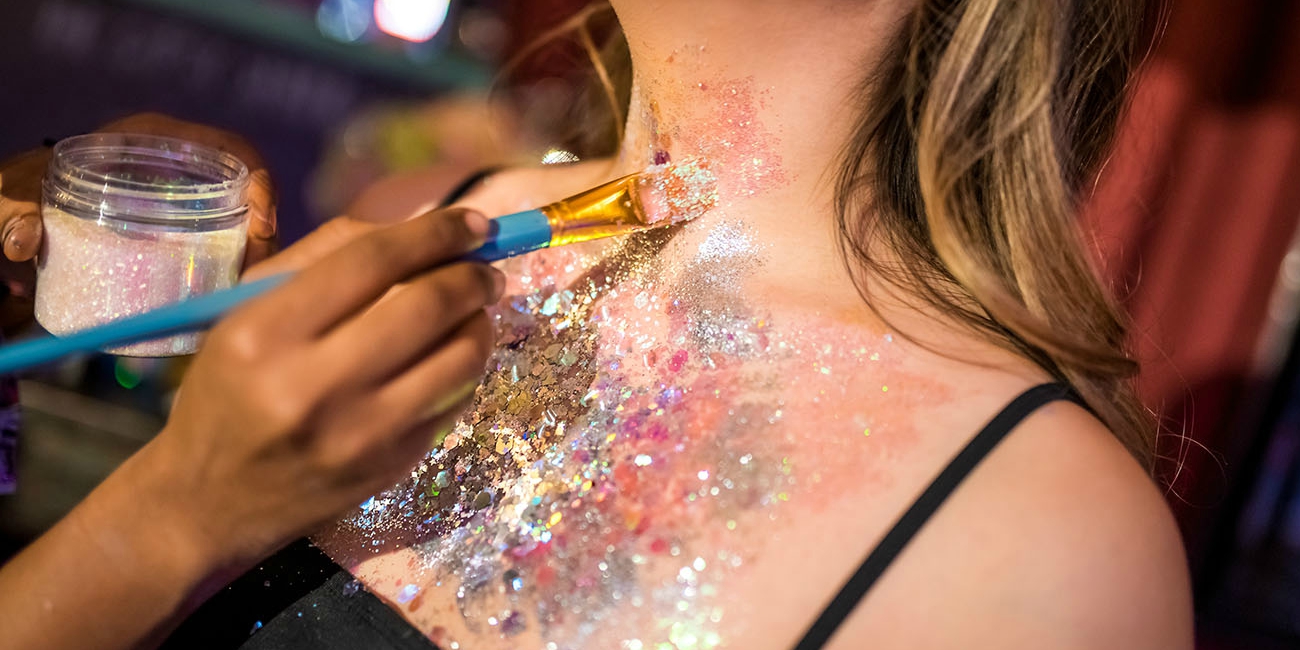Before dipping your makeup brush into that pot of glitter, consider the origins of the glittery substance.
To many people, glitter is more so the herpes of the arts and crafts world than something to beautify one’s self. Despite that, at every festival you attend to this year, you will likely find at least a handful of women and men with glitter on their boobs, faces, bums, and everywhere else possible. While glitter provides that extra kick to any makeup style or look, let’s take a deeper look at the substance.
Many people may not realize it, but most craft and body glitter used at festivals is made of plastic. While we can recycle plastic used in bottles and other items, one of the products we can’t recycle is plastic glitter. This is one of the main issues with non-biodegradable glitter. Several cosmetics companies continue to make non-sustainable glitter out of plastic and polyethylene terephthalate. Additionally, many companies potentially add aluminum to glitter to provide a “shiny” look to the substance, but while such materials can be used to recycle, they are not biodegradable.
Even with filtration systems in place, plastic glitter finds its way to the oceans around the world.
I’ve seen girls apply glitter from their heads to their toes, but once you have transformed into a glittery star, how do you remove it? As much as one may try to wet wipe it away to toss it in the trash, once you take a shower those little glitter particles will typically find their way to the ocean by way of wastewater or sewage lines. At that point, the material becomes another plastic object floating in the water, a pollutant that you may not be able to easily see that still brings harm to the environment.
According to Laura Parker of National Geographic, the sparkly substance that finds its way into the ocean and “microplastics become food for plankton, fish, shellfish, seabirds and other marine life.” In turn, those of us who enjoy seafood may find ourselves eating fish with an extra helping of plastic if the trend of using non-sustainable glitter and other non-biodegradable plastics continue.

What can be done to minimize the environmental damage while still having glittery fun?
In response to the high cost of glitter on the environment, news outlets in the United Kingdom have reported that over 60 UK festivals are banning the use of any glitter made up of plastic. Through the Drastic on Plastic initiative, festivals call for the removal of any single-use plastics at events and give camping authorities to confiscate any glitter that is not “biodegradable” by 2021.
While this initiative does not currently apply to US festivals, many event promoters and companies who are focused on sustainability and protecting the environment have supported the initiative. With that in mind, the stance that both US-based companies and others around the world have can still change in the future to join the initiative, and we hope to see them do so.
On a personal level, you can also help slow the pollution that glitter brings to the environment. Minimize or phase out your usage of plastic glitter products and work towards making a full swap to biodegradable brands. Additionally, make sure to spread the word about the harm that glitter and other microplastics bring to the environment.

Now more than ever, festival glitter that is biodegradable needs to become a go-to item for our looks.
Though they may not currently offer glitter shaped in hearts, diamonds, or other looks, they are made with sustainable raw materials such as plant cellulose that biodegrades in water. There are plenty of companies that currently supply eco-friendly glitters such as EcoStardust or Glitter Revolution, and as they continue to grow we hope to see them expand their product line to include more styles in the future.
As for those who do not know what their glitter is composed of, please email or message the manufacturer to get more insight on the products you’re using. With more festival attendees using glitter and gems than ever before, we should all do our part in being socially responsible for promoting the use of the sustainable materials.
Looking for some tips on how to best utilize glitter this festival season? Check out our post highlighting ways to step up your festival game with glitter!







